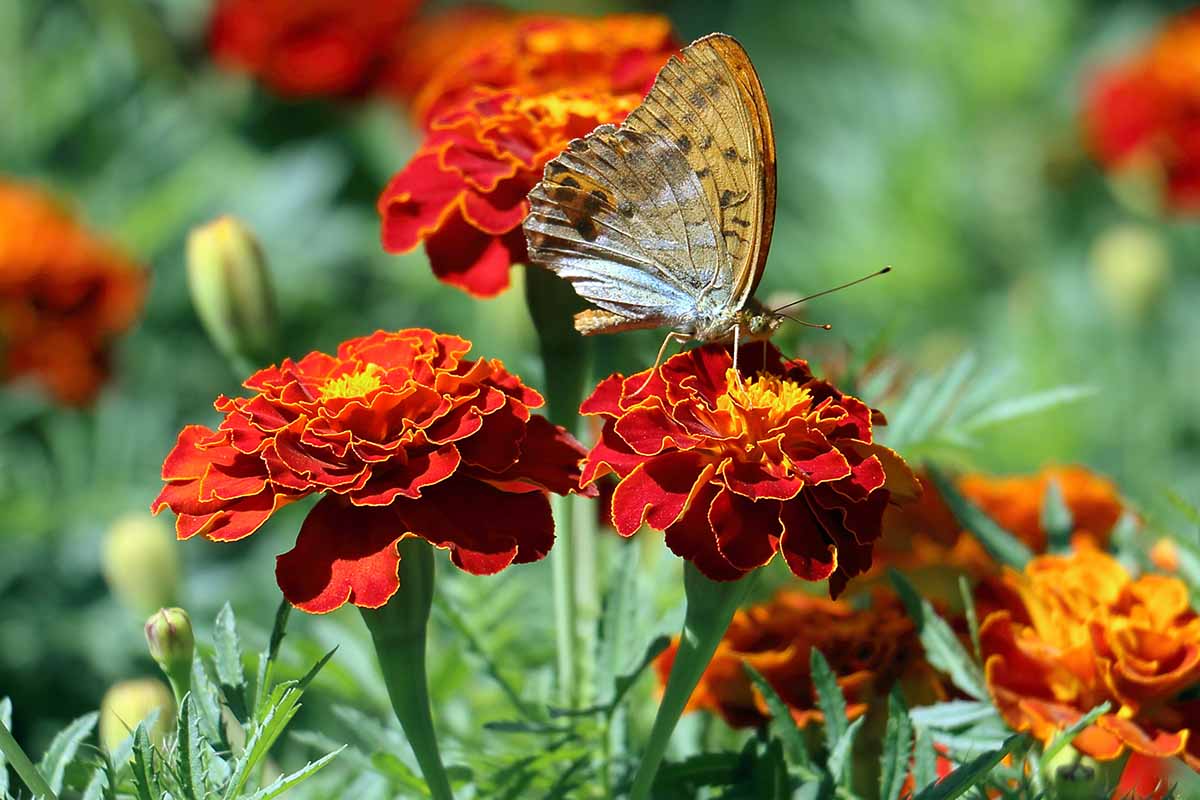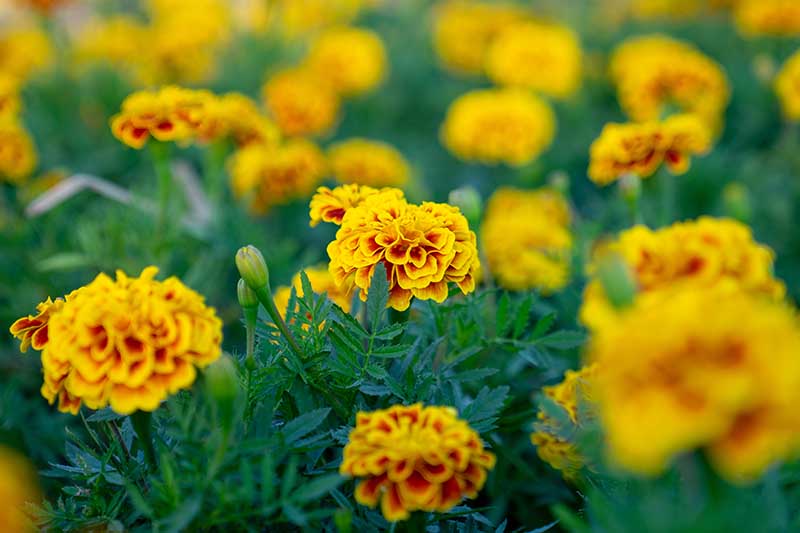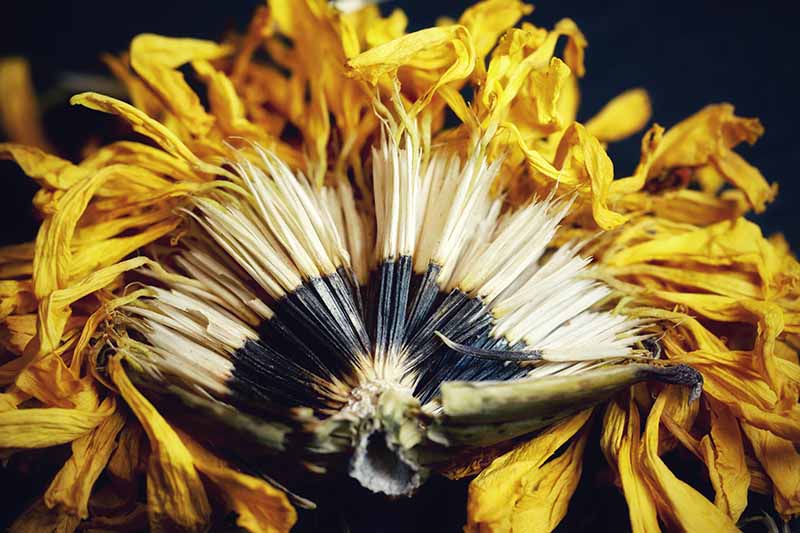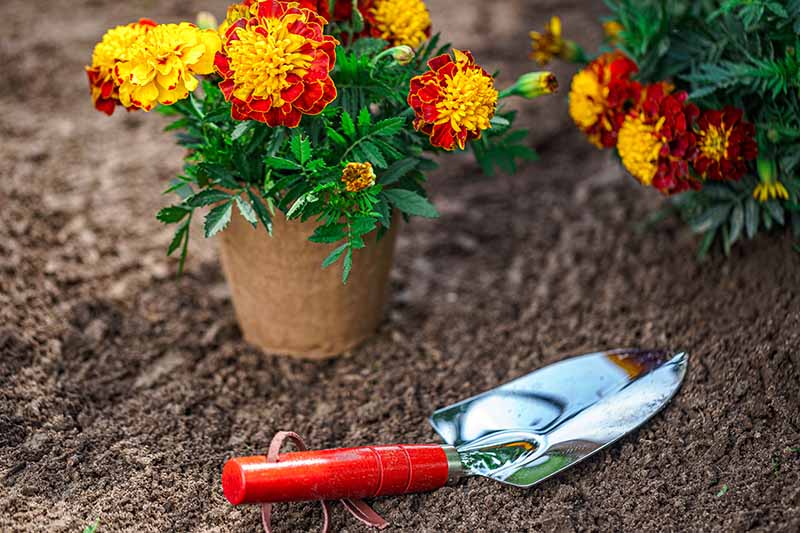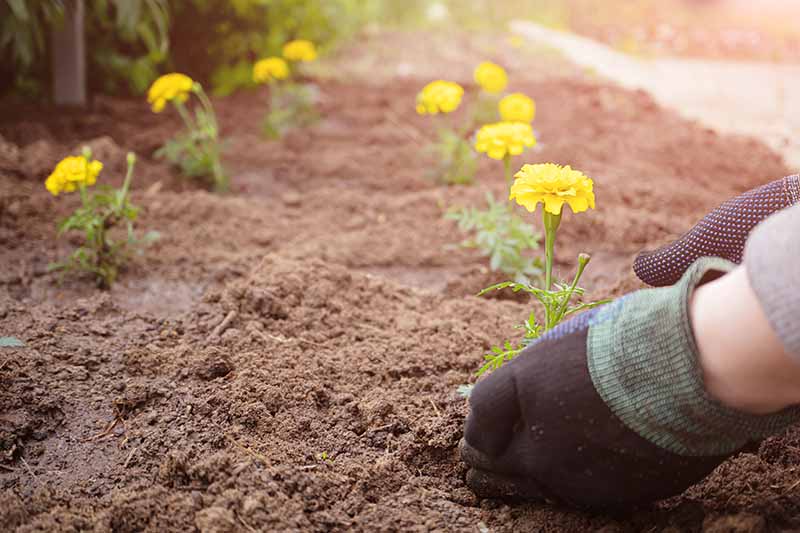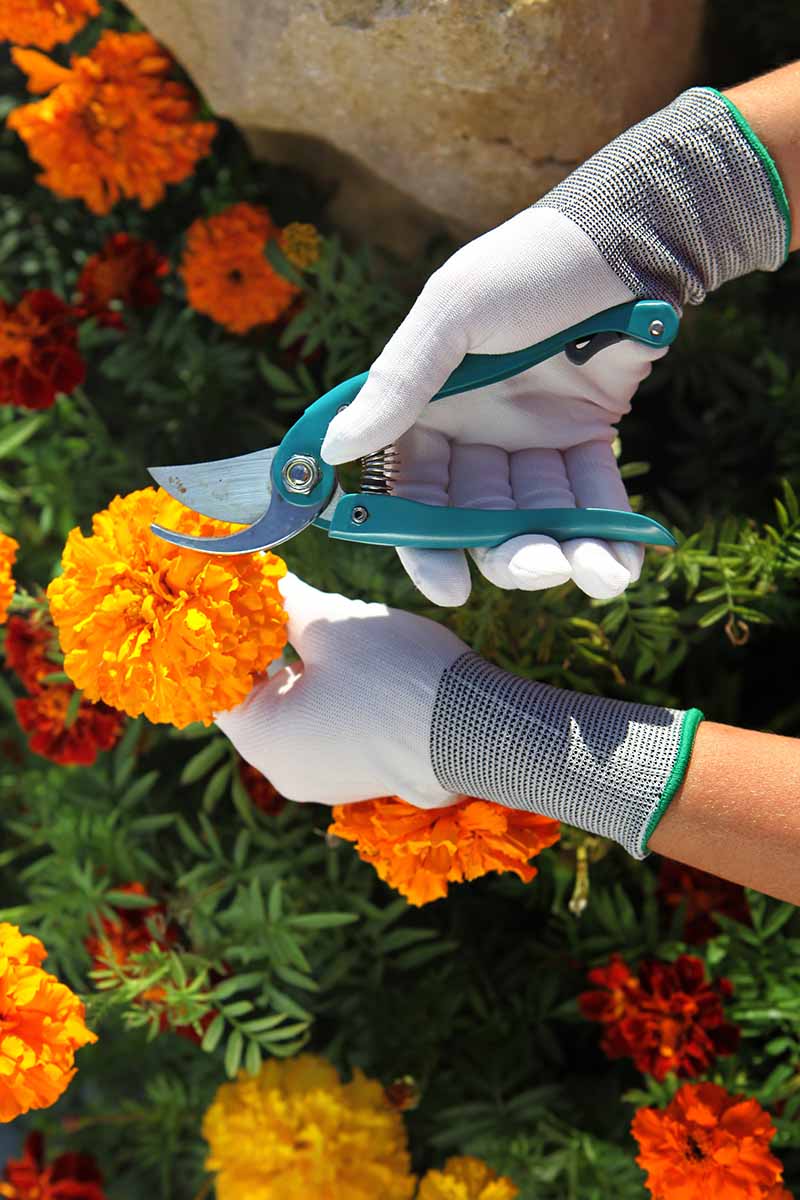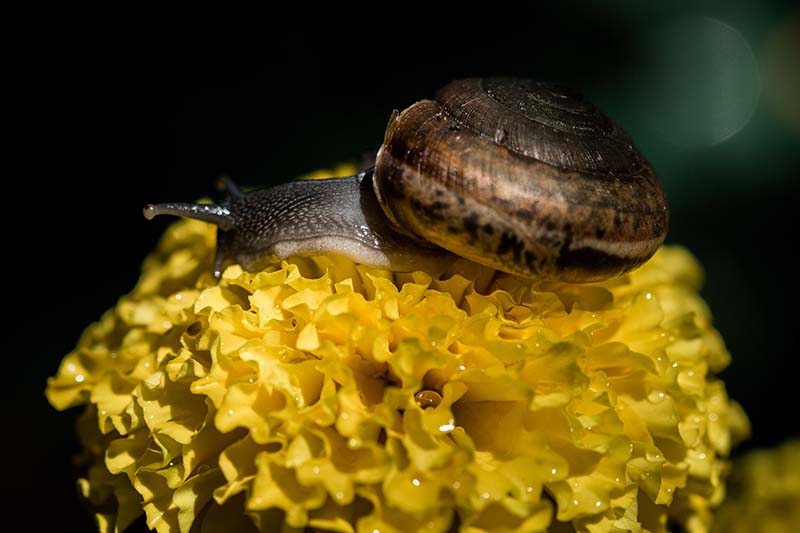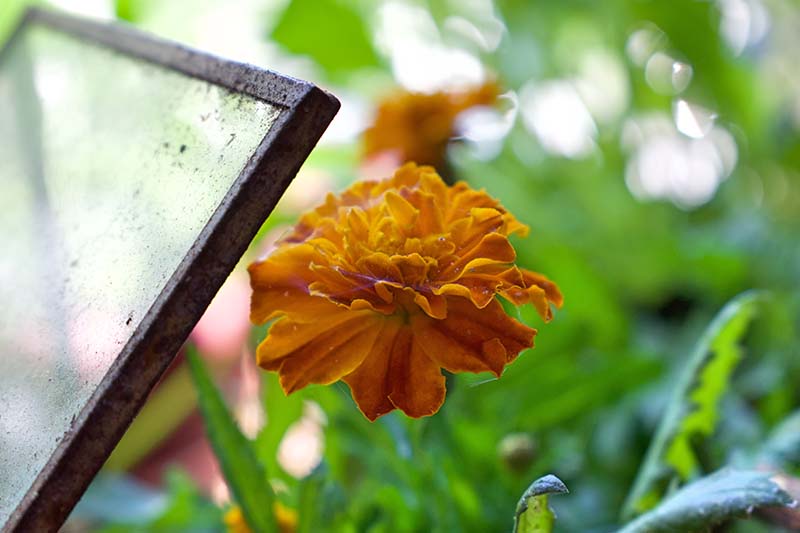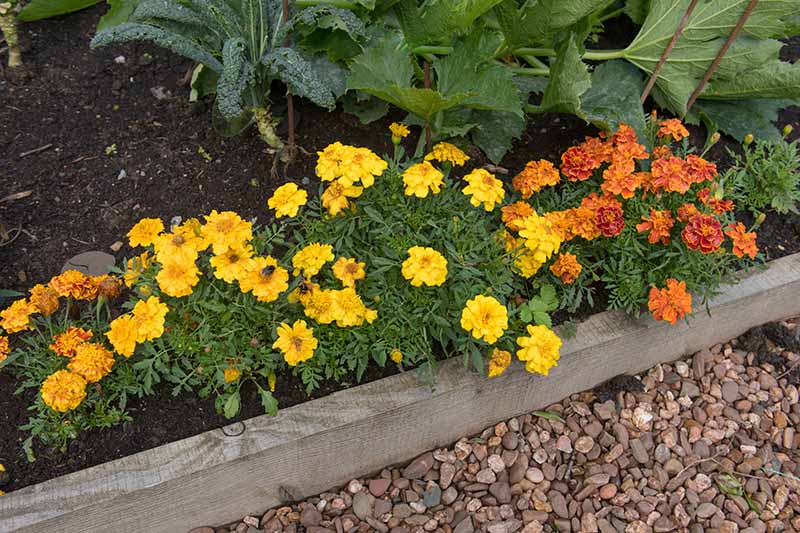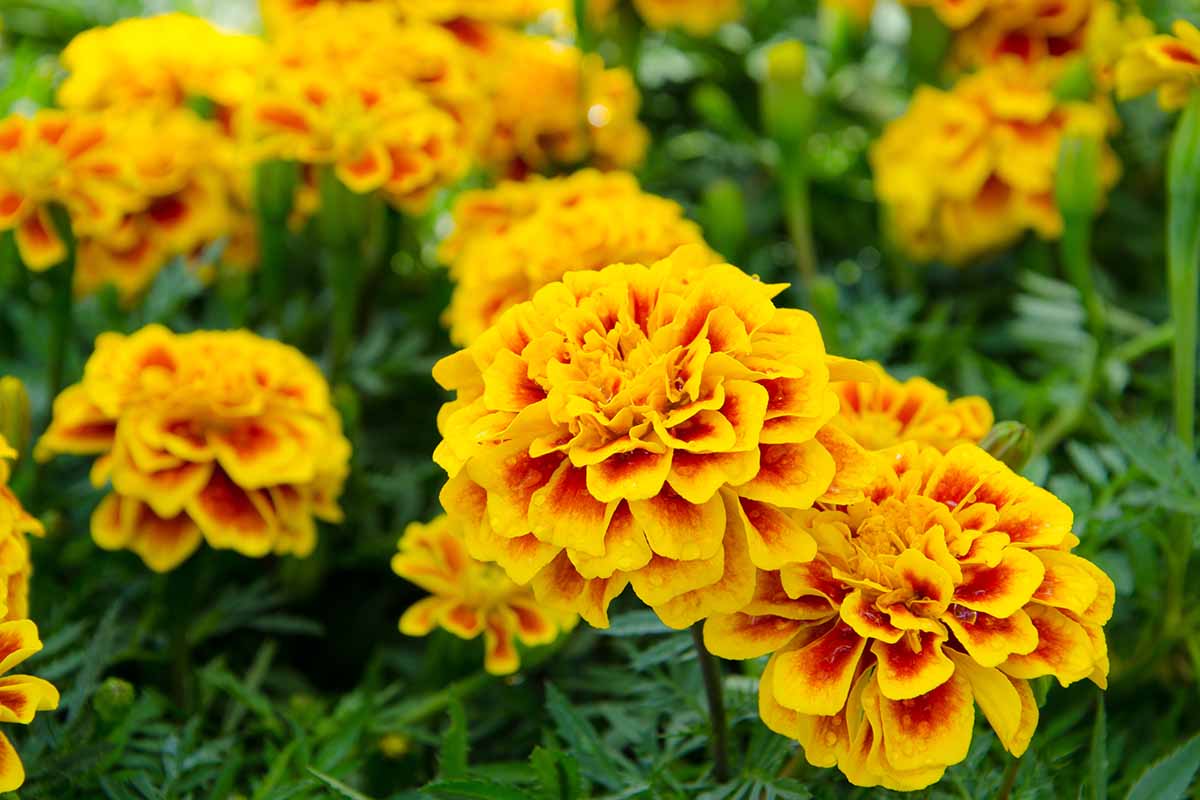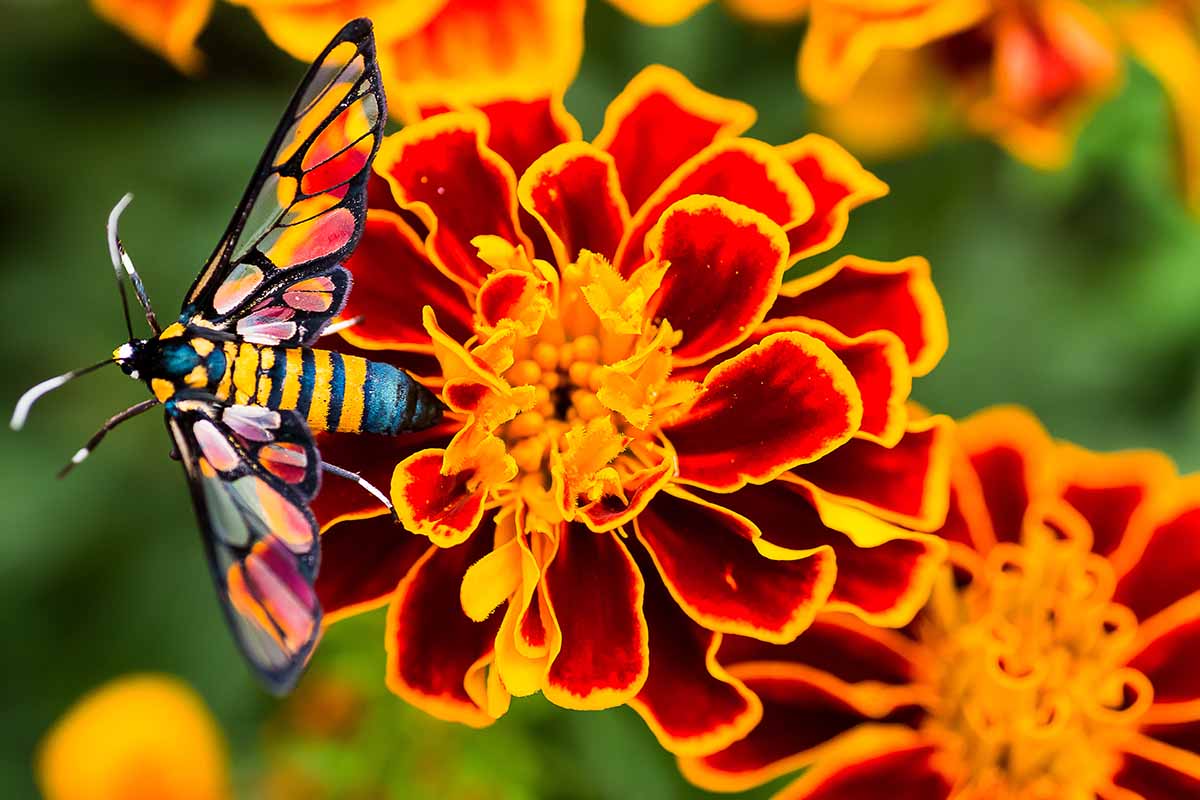The mounding, full, and frilly display of these fantastic flowers is a staple in gardens across the country – and no wonder, because it would be hard to find a flower this bold that is easier to grow. We link to vendors to help you find relevant products. If you buy from one of our links, we may earn a commission. While you can grow a beautiful display from any of the various species, French marigolds have something a little special going for them. We’ll discuss that and more, coming up. Here’s what you can expect: Cut flowers, yarn dye, nematode control, salad topping – French marigolds can do it all. Let’s get growing!
What Are French Marigolds?
French marigolds are part of the same family as sunflowers and asters, Asteraceae. They have dentate, oblong leaves that are typically dark green with an almost lacy appearance. The plants reach up to 12 inches tall and 18 inches wide, depending on the cultivar. Tagetes patula plants stand out because they have a wide, mounding growth habit rather than an upright, tall growth habit like other marigold species such as Mexican (also known as American, African, or Aztec) marigolds, T. erecta. In fact, “patula” means spreading. Size-wise, the flowers are somewhere right in between those of the African and signet species, T. tenuifolia. They are generally one or two inches across. French marigolds also have heavily ruffled petals, while African and signet marigold petals are smoother. You can find more color options for the former that’s the subject of this guide, while the latter two primarily come in shades of yellow and orange. French marigolds can be red, orange, yellow, and a range of combinations or intensities of those colors, with pom-pom-like double flowers (which are most common) or simpler single flowers. There is even a pink French marigold now! The flowers emerge in late spring, usually in May though this can vary depending on where you live, and stick around until the arrival of first frost. Marigolds are also edible. If you’ve ever crushed a flower between your fingers and inhaled the scent, you already have a sense of their spicy, herbal, slightly bitter flavor. French marigolds have a particularly notable flavor of orange peel with a hint of mint. The petals have the most appealing flavor, but you can eat the leaves as well. They’re much more bitter and are commonly used to make herbal tea. Some people love the scent of the plants, while others find it offensive. In “Craft of the Dyer: Colour from Plants and Lichens” by Karen Leigh Casselman, a must-have book if you wish to use homegrown plants to make dyes, marigolds are referred to as having an “unattractive” scent. Craft of the Dyer: Colour from Plants and Lichens These flowers are also tremendous for killing mosquito larvae. In the journal Bioresource Technology, V. S. S. Dharmagadda with the Department of Biosystems and Agricultural Engineering at the University of Kentucky, S. N. Naik and P. Vasudevan at the Center for Rural Development and Technology at the Indian Institute of Technology in New Delhi, and P. K. Mittal at the Malaria Research Institute in Delhi found that the essential oil from T. patula was very effective at preventing mosquito larvae from maturing into blood-sucking adults. Methanol extract from French marigolds can also be used to treat plant diseases caused by Botrytis cinerea, Fusarium moniliforme, and Pythium ultimum. And on top of that, these plants can reduce populations of lesion and root-knot nematodes by acting as a trap crop or by poisoning nematodes with the terthiophene that they produce in their roots. As if that weren’t impressive enough, French marigolds show potential in suppressing weeds. These plants have an allelopathic effect that can reduce the germination of nearby plants. This could be a negative if they’re impacting a nearby plant that you want to grow big and strong, or a positive for weed control.
Cultivation and History
Marigolds originated in an area ranging from what is now Mexico to Guatemala and humans have been making use of them for a long, long time. Aztec people used the plants medicinally, in food, and in ceremonies. Other native people, including the Cherokee and Navajo, used the plant as a skin wash, to treat sores, to relieve stomach issues, and to treat colds. Spanish explorers brought the flower to Europe in the 1500s in what we now call the “Columbian Exchange” and it rapidly gained a following in France. So despite being native to the Americas, it gained the moniker “French” marigold. Incidentally, it was also brought to China and India around the same time. In India, in particular, the plant became an important piece of culture there. It’s a large part of the festival of Diwali and is used in Ayurvedic medicine, though T. erecta is the species that’s most commonly used. Today, marigolds are still an important part of Mexican culture as well. They’re known as flores de muertos, or flowers of the dead, and their bright coloring is thought to guide the deceased to the altars constructed by those celebrating the Day of the Dead. Initially, local species were used in celebrations, but these days, the French marigold has made its way back from Europe to the place where it all started. This is no doubt in part because of the vast color range and showy flowers that have been cultivated over time. Speaking of, they’ve been introduced and cultivated in pretty much every location on Earth at this point, and the first hybrid, ‘Burpee Red & Gold’ was bred in 1939. They have naturalized in California, but they don’t become invasive there. In my Utah garden, I let them spread wherever they wanted, since the only things that wanted to grow naturally in the dry, heavy clay were goatheads, aka puncturevines (Tribulus terrestris) – because the seeds can and will puncture your bike tires over and over to the point where you consider carving an unpoppable tire out of wood. In a few spots, the French marigolds pushed out the goatheads and I had lovely red and orange displays without any work on my part, but they never tried to extend past the edges of my garden.
Propagation
There are two ways to add T. patula to your garden, and either one is fantastically easy.
From Seed
You can buy seeds or use the seeds from existing plants that have finished their growth cycle. In the past, I’ve just plucked the dried seedheads and rubbed them between my fingers to release the seeds onto the uncultivated soil below, and I always had masses of new plants the following year. There are better ways to go about ensuring that your plants come back, but I mention this to illustrate how easy the process is. If you intend to use seeds from an existing plant, let the flowers fade and close up. Once they’re dry and brown, pinch each seed head and place it in a paper bag. Once you’ve collected as many heads as you need, gently rub them between your palms to release the seeds back into the bag. Gently blow away the chaff, and place in a cool, dry spot to allow the seeds to dry. Read more about harvesting and saving marigold seeds here. To propagate, you should start your seeds indoors about two months before the last expected frost date, or outdoors after the last projected frost date. Don’t worry, an unexpected frost or two won’t hurt the seeds or the seedlings, so don’t be too concerned about timing. Seedlings should pop up in one to two weeks, or once soil temperatures are right around 70°F. For all the details on planting marigold seeds, read our comprehensive guide.
From Seedlings/Transplanting
We’ve all seen those masses of marigolds in flats at our local nurseries. They’re full of color and usually incredibly cheap. This is the ultimate bang-for-your-buck flower. If you don’t want to wait for seeds to emerge, you can usually pick up an armful of plants for a song. To plant, dump the flowers out of their containers onto the soil and forget about them. Okay, I’m not quite recommending this, but it’s just about that easy. You might want to amend your soil if you have heavy clay or sand because that will encourage a much larger display. Marigolds will grow in just about any type of soil, but they’ll give you more flowers if you plant them in loamy, well-draining soil. Use well-rotted compost to amend whatever type of soil you have. Next, dig a hole just a touch wider and the same depth as the pot your plant is growing in, and space the plants about eight inches apart. Squeeze the sides of the container, gently wiggle loose the roots, and put them in the ground. They should be sitting at the same height they were in the container. Fill in around each with soil and water well.
How to Grow
Marigolds like full sun. They can grow in partial sun, but the blossom display will be reduced and the plants might suffer from powdery mildew or other fungal diseases as a result. The soil should be rich, loamy, loose, and well-draining. But of course, not all of us have such lovely soil. Lucky for us, marigolds are fine growing in clay, sandy, or otherwise deficient earth. However, once again, you’ll have a better display if you amend your soil with plenty of well-rotted compost. The plants are drought-tolerant, but you will have a much better show if you keep them well-watered, especially when they’re young. Add water when the top two inches of soil have dried out. Though they stop producing blossoms once the first frost arrives, the plant will survive several hard frosts, so you can keep enjoying the existing display late into the fall.
Growing Tips
Plant in full sun.Keep young plants well-watered.Amend clay or sand with well-rotted compost.
Pruning and Maintenance
Deadhead the heck out of your marigolds. I love doing this job by pinching the heads off with my fingernails because my hands have an intense marigold scent afterward that I love. You can also use a pair of scissors or clippers if you prefer. The more often you remove the spent flowers, the more new blossoms you’ll have on an ongoing basis. If you miss a flower or two, don’t panic. Your plant will continue to flower. Just pick the spent seed heads when you notice them, and sprinkle the seeds into the garden if you’d like new plants to grow in the same spot. I’ve had “volunteers” pop up and grow into mature plants with full blossoms as late as September. The only exception to regular deadheading is toward the end of the season if you want to allow the plant to go to seed and self-seed into the garden, or if you’d like to save seeds to store or share. You can leave the blossoms on the plant, or wait until they’re brown and dry and then pluck the heads and rub them between your fingers to sprinkle the seeds into your garden manually. You can also store the dry seed heads in a paper bag in a cool, dry spot over the winter and plant them in the spring. Don’t expect the seeds to produce plants that are genetically identical to what you planted. You’ll likely see something different the next season, especially if you’re growing a hybrid. Once the end of the growing season arrives, chop up the plants with a spade and dig them into the soil. That will help to kill any nematodes in the soil in addition to acting as a bit of compost the next year.
Insects
I can honestly say that I’ve never had to deal with pests on my marigolds – one of few plants that can boast this claim to fame.
Court Jester
One look at ‘Court Jester’ and you’ll be imagining a playful clown thrilling the crowd. The single blossoms are distinctly striped with wide patches of yellow and maroon, with cheerful orange centers. ‘Court Jester’ Add this playful jester to your garden by picking up a packet, ounce, or quarter-pound of seeds at Eden Brothers.
Nema-Gone
Can you guess what this marigold excels at? While it has beautiful golden yellow, single flowers on a 10-inch-tall plant, testing has shown it to be particularly good at ridding your soil of nematodes. ‘Nema-Gone’ If you’ve been battling these microscopic worms, grab yourself 2,000 seeds at Burpee and sow them in your garden in the year (or months!) before you intend to plant your primary crop.
Strawberry Blonde
Do you remember that we mentioned a pink marigold earlier? ‘Strawberry Blonde’ has heavily ruffled double blossoms in pale pink, salmon, and yellow. ‘Strawberry Blonde’ When the cool fall weather comes around, the blossoms take on a pinkish-plum tone. The 10-inch-tall plants are extremely beautiful and sure to draw comments from anyone who sees them. Burpee carries bundles of 12 live plants and packets of 50 seeds if you’re hoping to make this beauty a part of your garden.
Tiger Eyes
You never thought you’d be staring into the eye of the tiger the next time you strolled through your garden – right? When you plant ‘Tiger Eyes,’ you’ll be greeted by showy double blossoms with a bright red outline of large petals and smaller, sunny orange petals clustered in a pom at the center. ‘Tiger Eyes’ The plant reaches a foot tall and has long stems, which makes it perfect for cut flower displays. Pick up a small packet, an ounce, a quarter-pound, or a one-pound container of seeds at Eden Brothers.
Triple Threat
‘Triple Threat’ is a treat that gives you three different blossom colors on one 10-inch plant. You can expect yellow, orange, red double blossoms all summer long, even without deadheading. ‘Triple Threat’ Snap up 50 seeds at Burpee.
Managing Pests and Disease
If you live somewhere that you constantly have to battle deer and mice in the garden, plant marigolds around and throughout your space. Herbivores don’t like the smell of the flowers. And neither, apparently, do aphids – this is one of the few plants that isn’t plagued by the little suckers. Still, they do have some pests and diseases that will strike now and then. Let’s take a look. That doesn’t mean they’re entirely pest-free 100 percent of the time, but if you keep them generally healthy, it’s rare to lose a plant to invertebrate visitors.
Slugs
Slugs will visit marigolds, sure. But they don’t seem to usually devour these plants like they might with hostas or creeping Jenny. Instead, they’ll stop and nibble on the leaves and then head off to greener pastures. You might only know they’ve been by because of the glossy trail they leave behind. Hand-picking is usually effective for controlling them, but we have lots of other tips in our comprehensive guide.
Spider Mites
Cursed spider mites! These little arachnids from the family Tetranychidae can’t get enough of marigolds, especially ones that are planted in full sun in a dry area. They can cover the entire plant in webbing and the leaves in yellow spots. And they suck the sap out of plants, weakening them considerably. Keeping your plants moist goes a long way toward deterring spider mites. But if they start chomping on your plants, read our guide to learn how to control them.
Disease
Marigold diseases are most likely to occur in plants that are receiving too much moisture, growing in poorly draining soil, located in too much shade, or a combination of these. Note that while Mexican marigolds are prone to Alternaria leaf spot, French species are resistant to this ailment – another mark in the plus column!
Powdery Mildew
Powdery mildew is caused by the fungal pathogen Golovinomyces cichoracearum, and it’s the only real disease threat your French marigolds may face. The first sign is usually powdery white spots on the lower leaves. These spots will gradually spread upward until the entire plant is covered, and the leaves and petals may also curl up. You can treat it as you would powdery mildew on any other plant. Our guide has plenty of tips to help you on your way.
Best Uses
French marigolds work well in containers, raised beds, or the ground. They can be used in ornamental beds, borders, or in vegetable gardens to help deter pests. It’s hard to go wrong with these plants in the garden. I’ve seen evenly-spaced, well-ordered lines of marigolds that look just as fantastic as random, natural mounds of them interspersed throughout the garden. The one constant here is that they look best in groups – a single plant seldom looks as fabulous as a big old bunch of them. In addition to adding vibrant color, they also attract bees and butterflies. Obviously, they’re useful in the garden, but what about outside of it? The petals can be used as a dye, and they’re also edible. You can read more about growing marigolds for edible use in our guide. Of all varieties, French marigolds in particular are fabulous for creating dye. Depending on how you process the flowers, you can obtain olive green, avocado green, yellow-gold, yellow-orange, bright orange, gold, ochre, rust, gray, bronze, or burnt orange dye. The color holds fast, so you don’t have to deal with fading as you might with many other species. The flowers can also be used as a dye in food, and the petals are often used for color in place of saffron. You can freeze the blossoms for long-term storage if you want. If you do so with the intent of using them for dye, separate them by color. Don’t wash them, just place the freshly-picked flowers in plastic bags and press the air out of them. Seal and place in the freezer. The flowers also work well in dried arrangements or potpourri. Hang them upside down by the stems or place single flowers in a layer on a screen and allow them to dry in a warm spot with good air circulation. While they don’t work as well as cut flowers as their cousin the Mexican marigold, they can still make a nice display in a short vase. If you’re a fan of floral art, you can also press the petals.
Quick Reference Growing Guide
Fall in Love with French Marigolds
I know that French marigolds are sometimes dismissed as common little flowers that have nothing special to offer. After all, they’re easy to find practically everywhere, and they’re cheap as heck. But I think they’re fantastic. It’s hard not to love a flower that not only deters evil pests, but attracts good bugs, needs hardly any care, and gives you color galore. I’m dying to know what cultivar you end up selecting. Let us know in the comments section below. I hope this guide helped you become more familiar with French marigolds and empowered you to put them to use in your garden. And if you are interested in learning more about growing marigolds, check out these guides next:
How to Plant and Grow the Glorious Marigold31 of the Best Types of MarigoldsBenefits of Companion Planting Marigolds with Tomatoes

